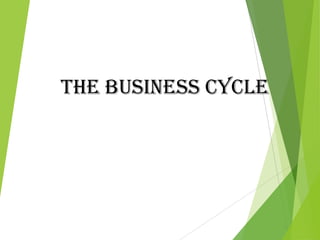
Economic cycle slide
- 2. What is a business cycle? A business cycle refers to periods of expansion and contraction. A peak is the high point following a period of economic expansion. A trough is the low point following a period of economic decline.
- 3. Cont...... The recurring and fluctuating levels of economic activity that an economy experiences over a long period of time.
- 5. Fluctuation of cycle Business cycles are a type of fluctuation found in the aggregate economic activity of nations that organize their work mainly in business enterprises. A cycle consists of: Expansions. General recessions. Contractions And revivals which merge into the expansion the next cycle. phase of
- 6. According to Joseph Business Cycle has 4 steps….. Expansion: Increase in production and prices, low interests rates. Crisis: Stock exchanges crash and firms occur. Recession: Drops in prices and in output high interests rates. Recovery/Revival: Stocks recover because of the fall in prices and incomes. multiple bankruptcies of
- 8. PHASES OF BUSINESS CYCLE Steady growth line Peak DEPRESSION Line of cycle Trough
- 9. Boom The business outlook is extremely optimistic. The important features of prosperity are: a high level of output ,trade, employment and income, a high level of effective demand and high marginal efficiency of capital, a large expansion of bank credit, and a rising trend in prices, profits and interest rates.
- 10. Characterized by Slackening in expansion rate PEAK Highest level of prosperity Downward slide in economic activities The phase of recession begins
- 11. Recession During recessions, many macro economic indicators vary in a similar way. Production, as measured by gross domestic product (GDP), employment, investment spending, capacity utilisation, household incomes, business profits, and inflation all fall while bankruptcies and the unemployment rate rise.
- 12. Downward slide in growth rate becomes rapid and steady RECESSION Output, employment, prices etc. register a rapid decline When the growth rate goes below the steady growth rate depression sets in
- 13. Depression The phase of depression economic activity is at its low . Wages, cost, price are very low. There is massive unemployment leading to a fall in the aggregate income of the people. This brings down the purchasing power of the community. General demand falls faster than production. The piled-up stock are sold at very high rates of discount leading to heavy loss to the firms.
- 14. Depression begins when Growth is less than zero DEPRESSION Total output, employment, prices, bank advances etc. Decline during subsequent period Depression lasts as long as growth rate stays below the stagnated growth rate
- 15. Phase during which the downward trend in the economy slows down and eventually stops Economic activities once again register an upward movement TROUGH Period of severe strain on the economy Economy registers a continuous and rapid upward trend in output,employment, etc. It enters the phase of recovery
- 16. Recovery The rising price of an asset Increased economic activity during a business cycle, resulting in growth in the gross domestic product. Collection of all or a portion of a debt previously considered uncollectible. Valuable materials remaining after processing. Proceeds from the sale of an asset that represent depreciation that has already been taken.
- 17. Increase in Output Employment Investment EXPANSION Aggregate demand Bank credits Wholesale & Retail prices Per capita output Standard of living
- 18. RECOVERY & EXPANSION In the recovery phase the growth rate may still remain below the steady growth rate. When it exceeds this rate, the economy enters the phase of expansion And prosperity
- 20. DEPRESSION PRICE LEVEL FALLS STOCKS ACCUMULATE PRODUCTION DECREASES PRODUCTION FALLS UNEMPLOYMENT INCREASES PRODUCTIVE ACTIVITY SLOWS DOWN PURCHASING POWER DECREASES DEMAND FALLS
- 21. RECOVERY DURING DEPRESSION ONLY CONSUMER GOODS ARE PURCHASED DURABLE GOODS REMAIN UNSOLD OLD DURABLE GOODS EITHER GET CONSUMED OR BECOME OBSOLETE PURCHASE OF GOODS AGAIN BECOMES NECESSARY PRODUCERS PURCHASE THESE GOODS FULL EMPLOYMENT PROGRESS IN BOTH INDUSTRIES ENCOURAGEMENT TO PRODUCE CONSUMER AS WELL PRODUCTIVE GOODS GREATER PRODUCTION OFCAPITAL GOODS INCREASE IN DEMAND FOR CONSUMER GOODS INCREASE IN EMPLOYMENT PRODUCTION IS ENCOURAGED
- 22. BOOM EMPLOYMENT INCREASE THERE IS OVERALL PROSPERITY WAGES RISE AS A RESULT THE LEVEL OF EMPLOYMENT, INCOMES AND TRADE ALSO RISE DEMAND INCREASES LEVEL OF INVESTMENT INCREASES PRICES RISE PROFITS RISE MORE THAN WAGES
- 23. RECESSION INCREASED DEMAND DURING BOOM BEGINNING OF DEPRESSION BRINGS IN LESS EFFICIENT MEANS OF PRODUCTION PRICES OF COMMODITIES RISE SHARPLY MONEY MARKET ALSO BECOMES COSTLIER COST OF PRODUCTION GOES UP DEMAND FOR LOANS PUSHES UP INTREST RATES QUANTITY OF INVESTMENT BEGINS TO DECREASE
- 24. Theories of Business Cycle… • Keynesian Theory Fluctuations in aggregate demand cause the economy to come to short run equilibrium at levels that are different from the full employment rate of output. These fluctuations express themselves as the observed business cycles. ?
- 25. NEED FOR CONTROLLING BUSINESS CYCLES Business Cycles Harm to business community Create unemployment and poverty Hence the need to create stabilization Through Government Intervention
- 26. Thanks
- 27. REFERENCE LIST A. F. Burns, Introduction. In: Wesley C. Mitchell, What happens during business cycles: A progress report. New York, National Bureau of Economic Research, 1951 kitchin, Joseph (1923). "Cycles and Trends in Economic Factors". Review Economics and Statistics (The MIT Press) 5 (1): R. M. Goodwin (1967) "A Growth Cycle", in C.H. Feinstein, editor, Socialism, Capitalism and Economic Growth. Cambridge: Cambridge University Press
